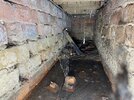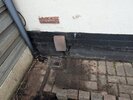- Joined
- 11 Nov 2024
- Messages
- 7
- Reaction score
- 0
- Country

Just looking for advice. 1930s semi detached suspended timber flaws although I think there may be some concrete on top within the kitchen area. Terrible at DIY, but I at least want to diagnose it yourself so I can try and get appropriate solutions.
Found a tidal mark on an internal wall in front room, separating hall from front room. On opposite side of wall to a radiator which has had some flaking of paint underneath long term. This tidal mark as far as I know is new.
I looked under some floorboards which showed lots of rubble which was wet and then at the front of the house some standing water (pic attached). At the front of the house there is a downsloping drive with a small drain in the corner.
Got a damp surveyor in who suggested getting drain checked by water company due to its proximity to standing water. They said the joists appeared okay. Water company couldn't get camera in and when tried to jet it, more water entered house at front. Thought could be collapsed so came back to dig up, found drain discharging into ground with outflow partially obstructed by a brick but with no gravel etc. As not connected to mains not there problem but they kindly filled dug hole with gravel.
Spoke to a local builder who said a lot of these houses have damp subfloor voids.
This damp mark is diagonally opposite area.
I'm thinking of selling house soon so have the issue of wanting to get it sorted for next person but not wanting to pay too much if it can be helped.
My plan is to connect this drain to the main sewer (if allowed - I think my downpipe drains into main sewer), install an aco drain across the front of the house and dry out the wall (almost dry now I think but has a water mark) and hope that's the issue. I'm also not sure whether it's worth getting the under ground bricks repointed.
What I don't understand is why it is this wall in particular and is the pooling of water at the front a red herring/should I be looking for something else. A leak detection company came out and found no evidence of a leak from radiator or water supply. Not sure if it could be condensation related but seems unlikely to just be this wall rather than an external one. There are four air bricks at front and two at back. One also at side. The pool of water is now gone but the ground remains damp. I discovered this shortly after storm Ashley, not sure if relevant. House has had previous intervention for damp/rot by previous owners in this room although nothing to sort out poor drainage of drive (replacing some timber, installing another air brick).
Any advice appreciated.
Thanks.
Found a tidal mark on an internal wall in front room, separating hall from front room. On opposite side of wall to a radiator which has had some flaking of paint underneath long term. This tidal mark as far as I know is new.
I looked under some floorboards which showed lots of rubble which was wet and then at the front of the house some standing water (pic attached). At the front of the house there is a downsloping drive with a small drain in the corner.
Got a damp surveyor in who suggested getting drain checked by water company due to its proximity to standing water. They said the joists appeared okay. Water company couldn't get camera in and when tried to jet it, more water entered house at front. Thought could be collapsed so came back to dig up, found drain discharging into ground with outflow partially obstructed by a brick but with no gravel etc. As not connected to mains not there problem but they kindly filled dug hole with gravel.
Spoke to a local builder who said a lot of these houses have damp subfloor voids.
This damp mark is diagonally opposite area.
I'm thinking of selling house soon so have the issue of wanting to get it sorted for next person but not wanting to pay too much if it can be helped.
My plan is to connect this drain to the main sewer (if allowed - I think my downpipe drains into main sewer), install an aco drain across the front of the house and dry out the wall (almost dry now I think but has a water mark) and hope that's the issue. I'm also not sure whether it's worth getting the under ground bricks repointed.
What I don't understand is why it is this wall in particular and is the pooling of water at the front a red herring/should I be looking for something else. A leak detection company came out and found no evidence of a leak from radiator or water supply. Not sure if it could be condensation related but seems unlikely to just be this wall rather than an external one. There are four air bricks at front and two at back. One also at side. The pool of water is now gone but the ground remains damp. I discovered this shortly after storm Ashley, not sure if relevant. House has had previous intervention for damp/rot by previous owners in this room although nothing to sort out poor drainage of drive (replacing some timber, installing another air brick).
Any advice appreciated.
Thanks.
Attachments
Last edited:



